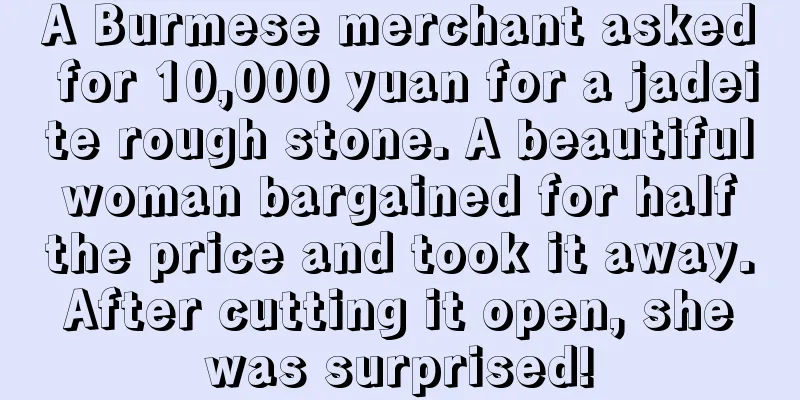Only by understanding the texture of jadeite can you distinguish the quality of jadeite

|
People who don’t understand jade may just marvel at its luster and appreciate the visual impact it brings. If you want to understand jade, you should carefully understand the texture of jade. The texture of jade is the arrangement and order of crystal particles inside jade. Due to the long-term geological effects, jadeite raw stones are in a state of high pressure for a long time. The columnar crystal structure inside the jadeite will grow along the areas with less pressure, forming lines in the jadeite raw stones. The textures that exist inside the jade but are difficult to judge from the outside are mostly formed in the early stages of jade. The geological movement is caused by internal stress. In subsequent geological processes, they are often filled and healed by later minerals, so they are generally closed. Jade textures can be divided into: fly wing texture, orange peel texture, B+C acid etching texture based on their shape, and can be divided into: longitudinal texture and reverse texture based on their arrangement order. On the mineral crystal surface and crystal cleavage surface that form jade, under light, the crystal surface and cleavage surface appear as needle-shaped, columnar or flaky shiny surfaces, much like the wings of an insect fly, referred to as "fly wings". The crystals of glass-type and ice-type jade are very small, and the "jade quality" is almost invisible, and it is difficult to see with the naked eye. Orange peel texture is jade-like wrinkles caused by the different hardness of jade's columnar and fibrous crystals. The high-hardness crystals are raised, while the low-hardness crystals are sunken. This unique phenomenon is called the orange peel effect. The acid etching marks are caused by the corrosion of strong acid in Jade B cargo. The gaps between jade mineral particles are very obvious. There is no smooth transition between the protrusions and depressions, but a crack separating them, forming cracks that penetrate between the jade mineral particles. These are called "acid etching marks". It can be said that jadeite with acid etching marks should never be purchased. The raw stones on the jade market are also called seed materials, that is, jade gravel. The outer layer of the gravel is tightly wrapped by a weathered crust, which varies in thickness and has poor uniformity. From a mineralogical point of view, the appearance and texture of this skin vary greatly, and the grain is complex, sometimes very different from the internal mineral composition, and the color is difficult to grasp with the naked eye alone. Real jade appears transparent on the outside, but your internal texture can be seen under the light, and the stone structure is natural, delicate and smooth. Jade itself is a unique mineral that was formed and metamorphosed under conditions of low temperature and extremely high pressure after thousands of years of crustal movement. Like all minerals, chemical synthesis of jade is impossible, and there are absolutely no two identical jades in the world. Even if they look exactly the same on the outside, their internal texture structures are different, so each piece of jade is unique. Therefore, the unified standard pricing for different jades is also different.
feicuibbs feicuibbs9 |
<<: Correct identification method of jadeite
>>: Do you know how to identify jade?
Recommend
How to choose jade egg-shaped beads?
Jade egg-shaped faces are also called jade ring f...
Teach you how to distinguish B and C grade jadeite
I wonder if you have any questions at this point....
Jade carving is not easy, the most important thing is to know how to appreciate it!
The ancients said, "If jade is not carved, i...
Black Jade: The “Scholar” among jades, who makes his own voice without making any noise!
In recent years, black jade has quietly appeared ...
Learn these four points to easily choose a perfect jade bead necklace
Popular actresses such as Liu Yifei, Huang Shengy...
An old lady licks a bracelet in a shopping mall. Is it reliable to use this method to identify the authenticity of jadeite?
Recently, in a jade mall, an old lady licked more...
“Wherever a dragon goes, there is water.” Cutting such a raw stone is really thrilling! ! !
Dragonstones have always been objects that live i...
How much is the wisest thing to spend on jade?
How much is the wisest thing to spend on jade? Le...
Although the jade has only a thin layer of yellow mist, the carving is very delicate and charming.
There are some jade materials, although their wat...
Value, collection...From what angles do experts look at jadeite?
When it comes to jade, consumers will pay attenti...
How to tell the authenticity of jadeite with the naked eye?
With the improvement of people's living stand...
Legendary Jadeite - Hutton-Mdivani Jadeite Bead Necklace
Let’s take a look at a piece of extremely well-kn...
Is black jadeite pure black jade?
Jadeite appears black on the surface, and the bet...
How to correctly understand high ice jadeite? Don't be fooled
To judge the quality of jadeite, the most importa...
Carving a "cicada" out of an ordinary jadeite stone, does it feel like jade carving is very simple?
Today I will show you the process of carving a &q...









